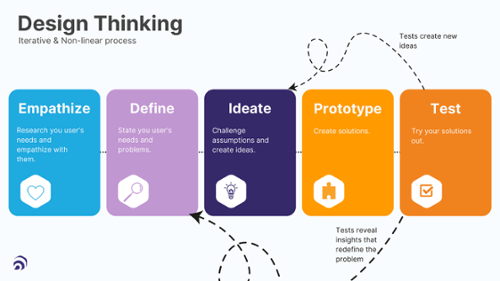Design Thinking: think outside the box
It is easy to say that thinking outside the box allows us to solve complex problems innovatively, but putting it into practice can be a big challenge...
Do you want to design a product or service that works? If you are thinking of using Design Thinking, you should know that a fundamental element that you cannot ignore is the empathy stage. But what is empathy, and why is it important in this methodology? Read on to learn more about human-centered design, designed to create solutions that work for people.
Index
Design Thinking
Design Thinking is a methodology that facilitates problem-solving, using creativity and design tools as drivers of innovation. According to Tim Brown - CEO of IDEO - Design Thinking is a collaborative, human-centered approach that uses a design mindset to solve complex problems.

Design Thinking stages
Being a methodology, the application of Design Thinking is thought of as a series of steps, although it is considered an iterative and non-linear process. The executing team can use the result of a stage to evaluate and improve a previous phase.
The stages of the process are:

All stages are essential; however, we will specifically talk about the first stage: Empathy, in this blog.
Stage One: Empathy
Empathy is a capacity that human beings develop, with which they see the world through the eyes of other people. It is about understanding their feelings and experiencing things as they do. Leaving aside paradigms and one's preconceived ideas, one can empathize with people, their vision, feelings, and experiences.
According to IDEO, in Design Thinking, empathy is a "deep understanding of the problems and realities of the people you are designing for." In other words, it is necessary to immerse oneself in the users' day-to-day lives for whom the solution is being designed, seeking to understand their environment, functions, and interactions.
When you empathize with people, you can analyze and transform negative experiences into pleasant situations for the user, thus improving the customer experience (CX).
Importance of empathy in Design Thinking
As I mentioned before, Design Thinking is a human-centered methodology, being that the main reason why "empathy" is the first stage of the process, but also because empathy helps to:

The empathy stage is the ideal time to gather information and observations and understand the experiences and perceptions of the users to build a solid foundation for the rest of the Design Thinking process (define, ideate, prototype, and test). Several methodologies and tools can be used for this first stage, such as the following:
Performing observations based on photos or videos makes it possible to discover the needs of the users concerning the problem to be solved and the emotions they experience. These observations should be done in a natural environment or during scheduled sessions with the team.
Depending on the problem to be solved, it may make sense to give control of the camera to the users along with instructions for them to take photos and videos of their activities during a set time. The difference with the previous methodology is that the equipment does not interfere until it is necessary to collect the observations.

Conducting interviews is a way of getting to know users and gaining an empathetic view of their needs, desires, and objectives.
Bodystorming is a technique in which you physically experience a situation to immerse yourself entirely in the users' environment. Bodystorming puts the team in the users' shoes and thus enhances the empathy they feel for their target group.

In conclusion, the empathy phase - the first one in the Design Thinking process - is essential because it allows us to discover and understand the needs, desires, objectives, and emotions of the people for whom we are designing, establishing the basis for a solution that meets the three circles of innovation: desirability, feasibility, and viability.

It is easy to say that thinking outside the box allows us to solve complex problems innovatively, but putting it into practice can be a big challenge...

We face challenges that test our creativity and ingenuity every day, so we must generate ideas to address various challenges. However, only some of...

Do you understand what the primary needs your customers seek to satisfy are? What is their objective, and what frustrates them in the process? Do you...